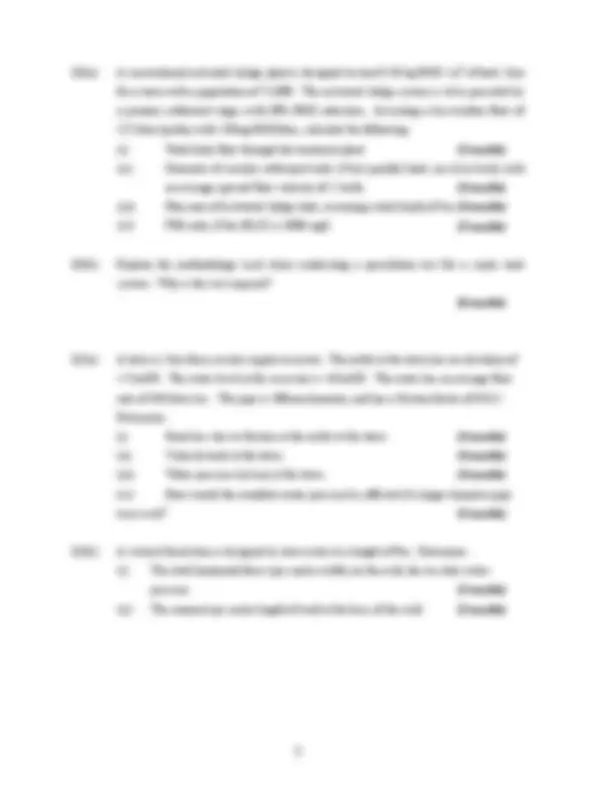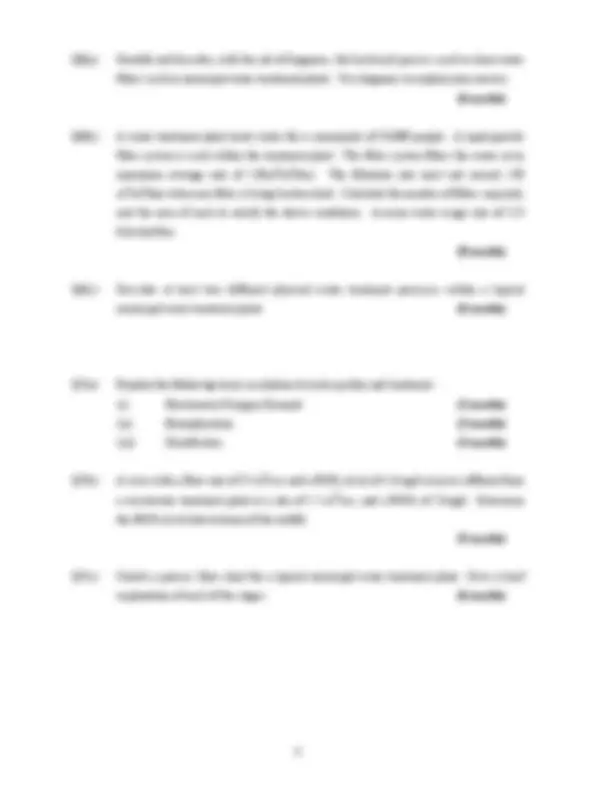




Study with the several resources on Docsity

Earn points by helping other students or get them with a premium plan


Prepare for your exams
Study with the several resources on Docsity

Earn points to download
Earn points by helping other students or get them with a premium plan
Community
Ask the community for help and clear up your study doubts
Discover the best universities in your country according to Docsity users
Free resources
Download our free guides on studying techniques, anxiety management strategies, and thesis advice from Docsity tutors
Main points of this past exam are: Tipping-Bucket Rain Gauge, Waste Management Hierarchy, Landfill Liners, Leachate, Bottom Ash, Vermicomposting, Home Composting System, Manual Traffic Flow Survey, Saturation Flow, Amber Period
Typology: Exams
1 / 4

This page cannot be seen from the preview
Don't miss anything!



(NFQ – Level 6)
Instructions Answer 5 questions All questions carry equal marks.
Examiners: Mr. L O’Driscoll Mr J. Murphy Mr. P. Anthony
Q1(a) Explain the following hydrological terms: (i) Evapotranspiration (ii) River hydrograph (iii) Water table (iv) Tipping-bucket rain gauge (v) Rating Curve (10 marks)
Q1(b) Calculate the peak rain-water runoff from a car-park area, with plan dimensions 150m by 360m. The design rainfall used should be of 15 minute duration, with a 10 year return period. Use the Dillon equation to calculate rainfall intensity. Use the Rational Method to calculate runoff from the catchment areas. Assume 100% runoff from impermeable areas.
Dillon Equation (^35) p^15 t
Rational Equation Q(l/s) = 2.78 A(ha) I(mm/hr) (6 marks)
Q1(c) Explain methods which may be used to measure flows in a small stream or channel. (4 marks)
Q2(a) What is the EU Waste Management Hierarchy? Give a practical example of this. (5 marks)
Q2(b) What are the arguments for and against the use of incineration within an overall waste management strategy. (5 marks)
Q2(c) Explain the following terms: (i) Leachate (ii) Landfill liners (iii) Bottom Ash (iv) Vermicomposting (v) Home composting system (10 marks)
Q3(a) Explain the methodology involved when conducting a manual traffic flow survey for a typical road in an urban area. Give typical examples of forms used. (6 marks)
Q3(b) Discuss how public and private transport systems can be integrated to manage traffic within major urban areas. (4 marks)
Q3(c) Actual traffic flows (vehicles / hour) and approach widths (m) on a 2 phase, 4 way intersection are as follows:
North South East West Actual Flow 450 650 700 1200 Approach width (metres) 4.3 4.3 4.9 4.
The signals are set up with assumed starting delays of 2 seconds per phase and a one second all red phase. There is no red / amber period. Determine the optimum traffic settings, given the following:
Saturation flow (veh / hour) = approach width (m) x 430
1 Y
o (^) −
(10 marks)
Q6(a) Identify and describe, with the aid of diagrams, the backwash process used to clean water filters used in municipal water treatment plants. Use diagrams to explain your answer. (6 marks)
Q6(b) A water treatment plant treats water for a community of 10,000 people. A rapid gravity filter system is used within the treatment plant. The filter system filters the water at an maximum average rate of 120m^3 /m^2 /day. The filtration rate must not exceed 150 m^3 /m^2 /day when one filter is being backwashed. Calculate the number of filters required, and the area of each to satisfy the above conditions. Assume water usage rate of 225 litres/pe/day. (8 marks)
Q6(c) Describe at least two different physical water treatment processes within a typical municipal water treatment plant. (6 marks)
Q7(a) Explain the following terms in relation to water quality and treatment: (i) Biochemical Oxygen Demand (3 marks) (ii) Eutrophication (3 marks) (iii) Disinfection. (3 marks)
Q7(b) A river with a flow rate of 25 m^3 /sec and a BOD 5 level of 1.6 mg/l receives effluent from a wastewater treatment plant at a rate of 1.5 m^3 /sec, and a BOD 5 of 25mg/l. Determine the BOD 5 level downstream of the outfall. (5 marks)
Q7(c) Sketch a process flow chart for a typical municipal water treatment plant. Give a brief explanation of each of the stages. (6 marks)